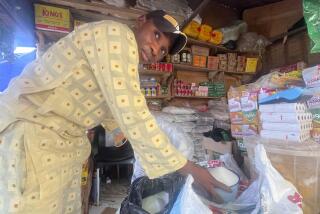From Stomach Ache to Headache : Once-Hungry Indonesia Satiated in Rice
- Share via
JAKARTA, Indonesia — Three straight years of bumper crops have made Indonesia’s dream of self-sufficiency in rice first a reality, and then a nightmare of oversupply.
“When there is not enough, we have a stomach ache. When there is too much, we have a headache,” one official said late last year as warehouses overflowed with rice.
Another bountiful harvest since then has the government grappling with the problems of plenty.
Low Quality, High Prices
Indonesia’s relatively low-quality, but high-priced, rice, as well as generous world supplies, has limited possibility for export, commercial grain dealers say. The price government buyers pays to farmers dropped more than 50% in recent weeks as available funds dwindled. Meanwhile, insects and rodents nibble at the surplus.
Officials at the National Logistics Bureau said after a recent survey that government warehouses held more than 2.7 million metric tons of rice. An additional 1 million tons or more are estimated to be in private storage facilities.
President Suharto said several years ago that the national goal was a stockpile of 5 million tons by 1989. Some experts have started to question the wisdom of such a large inventory, beyond purely political and psychological considerations.
‘Cost Becomes Apparent’
“Over the last 18 months, the financial and economic costs of holding substantial rice reserves have become more apparent,” said a recent World Bank analysis of Indonesia’s economy. The bank suggested a review of the longterm role of rice in the economy and said diversification into alternative food and cash crops might better serve the country’s farmers.
Politicians promised for years that Indonesia one day would grow enough rice to feed its people. As imported rice filled local bowls, that vow was replaced by talk of food crop or carbohydrate self-sufficiency.
In the 1970s, Indonesia was the largest buyer of rice in the world, sometimes accounting for as much as 20% of international purchases. Then came the “green revolution,” which included high-yield seeds, improved fertilizer and better pest controls, coupled with a series of excellent seasonal rainfalls.
The last significant import orders were placed in 1983 and most were either canceled or diverted to other buyers.
Staple foods vary from island to island in the Indonesia’s vast archipelago but rice, the predominant favorite, provides about half of the country’s protein and calories. About 15 million farmers plant it, with 60% grown on the island of Java.
Big Harvests
The main or wet-season crop accounts for two-thirds of Indonesia’s production. It is usually planted in November and December for harvesting four months later.
The Agriculture Ministry expects a harvest of more than 26 million tons of husked rice this year, after bringing in 25.8 million tons last year and 24 million in 1983. Indonesia’s 165 million people consume less than 25 million tons a year.
The National Logistics Bureau, long regarded as the buyer of last resort, has been reducing purchases by, for the first time, enforcing minimum quality standards for the grain.
More to Read
Sign up for Essential California
The most important California stories and recommendations in your inbox every morning.
You may occasionally receive promotional content from the Los Angeles Times.













